Eliza Knight's Blog, page 9
January 10, 2017
Three Sheets to the Wind
Lift your mug and toast with me. Today’s post is about what pirates loved to do best—drinking.
 You’ve probably heard the phrase “three sheets to the wind” and know it means to be very drunk. But did you know that this expression is seafaring in nature?
You’ve probably heard the phrase “three sheets to the wind” and know it means to be very drunk. But did you know that this expression is seafaring in nature?
It’s true, but its actual origin is likely not what you might guess. Three sheets to the wind, like flapping sails, that’s what you’re thinking, right? Typical landlubber mistake. Sheets don’t refer to sails at all. Nope. Instead, the sheets are the ropes that hold the lower corners of the sails in place. If the sheets (ropes) are loose, then the sails will not be drawn tight in the wind. They’ll flap. Flapping sails will cause a ship to stagger—much like a boozy, moon-eyed drunk.
If that isn’t fascinating enough, sailors used a scale to rate drunkenness. Because we all need to know our state of inebriation.One sheet = slightly buzzed, just enough to start troubleTwo sheets = drunk, tendency to fight or sing karaokeThree sheets = sloppy, can hardly stay upright, “I love you, man” plasteredFour sheets = out coldIn Dead Man’s Kiss , pirate captain Valeryn Barone had drowned his sorrows and became so belligerent drunk, somewhere between three and four sheets, he wound up in a fight to what he hoped would be his death. Instead, he got something much worse.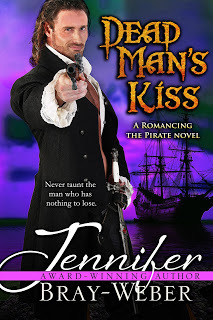 Click HERE for your copy!
Click HERE for your copy!
So the next time you’re throwing back the grog, wine, or spirits you can astound your mates with your amazing drinking knowledge. This has been a Public Service Announcement brought to you by the resident rum-swilling pirate wench.
About the AuthorJennifer is the award-winning author of the Romancing the Pirate series. Visit her at www.jbrayweber.com or join her mailing list for sneak peeks, excerpts, and giveaways.
 You’ve probably heard the phrase “three sheets to the wind” and know it means to be very drunk. But did you know that this expression is seafaring in nature?
You’ve probably heard the phrase “three sheets to the wind” and know it means to be very drunk. But did you know that this expression is seafaring in nature?It’s true, but its actual origin is likely not what you might guess. Three sheets to the wind, like flapping sails, that’s what you’re thinking, right? Typical landlubber mistake. Sheets don’t refer to sails at all. Nope. Instead, the sheets are the ropes that hold the lower corners of the sails in place. If the sheets (ropes) are loose, then the sails will not be drawn tight in the wind. They’ll flap. Flapping sails will cause a ship to stagger—much like a boozy, moon-eyed drunk.
If that isn’t fascinating enough, sailors used a scale to rate drunkenness. Because we all need to know our state of inebriation.One sheet = slightly buzzed, just enough to start troubleTwo sheets = drunk, tendency to fight or sing karaokeThree sheets = sloppy, can hardly stay upright, “I love you, man” plasteredFour sheets = out coldIn Dead Man’s Kiss , pirate captain Valeryn Barone had drowned his sorrows and became so belligerent drunk, somewhere between three and four sheets, he wound up in a fight to what he hoped would be his death. Instead, he got something much worse.
 Click HERE for your copy!
Click HERE for your copy!
Forced to make a bargain…One drunken night in Cuba lands Captain Valeryn Barone in a life or death situation. To escape the gallows, Valeryn must agree to a bargain only a fool would make: Escort the tempting and tenacious niece of his captor across the Caribbean or lose his ship, his crew and his life! The caveat? The beautiful Spanish woman must remain untouched for the entire voyage.
Determined to get what she wants…Catalina Montoya will stop at nothing to get what she wants—even when trouble is certain. Sent to live with her uncle after a scandalous affair, Catalina intends to concentrate on her dream to become a renowned naturalist. She never expected her uncle would send her with a notorious pirate to further her studies. Worse, she never expected to want the devilishly handsome pirate more than anything else.
It’s a battle of wills…Now Catalina only has 8 weeks to seduce Valeryn and collect her specimens before he returns her to her uncle. And Valeryn has 8 weeks to secure his redemption. Except neither would be that lucky. Not when ruthless enemies threaten to destroy them at every turn. Can Valeryn save those that foolishly depend on him? Can he resist Catalina’s heart? Does a dead man walking even have a chance?
So the next time you’re throwing back the grog, wine, or spirits you can astound your mates with your amazing drinking knowledge. This has been a Public Service Announcement brought to you by the resident rum-swilling pirate wench.
About the AuthorJennifer is the award-winning author of the Romancing the Pirate series. Visit her at www.jbrayweber.com or join her mailing list for sneak peeks, excerpts, and giveaways.
Published on January 10, 2017 01:00
December 30, 2016
Historical Fiction Review: Victory by Daisy Goodwin

I had the extreme pleasure of reading Victoria by Daisy Goodwin. The book was phenomenal and now I'm clearing my schedule to watch the show Victoria on PBS, also written by Ms. Goodwin, on January 15th! So, you have 2 weeks to read the book before the show!!!
From the Publisher..."Victoria is an absolutely captivating novel of youth, love, and the often painful transition from immaturity to adulthood. Daisy Goodwin breathes new life into Victoria's story, and does so with sensitivity, verve, and wit." ~ AMANDA FOREMAN
Drawing on Queen Victoria’s diaries, which she first started reading when she was a student at Cambridge University, Daisy Goodwin—creator and writer of the new PBS/Masterpiece drama Victoria and author of the bestselling novels The American Heiress and The Fortune Hunter—brings the young nineteenth-century monarch, who would go on to reign for 63 years, richly to life in this magnificent novel.
Early one morning, less than a month after her eighteenth birthday, Alexandrina Victoria is roused from bed with the news that her uncle William IV has died and she is now Queen of England. The men who run the country have doubts about whether this sheltered young woman, who stands less than five feet tall, can rule the greatest nation in the world.
Despite her age, however, the young queen is no puppet. She has very definite ideas about the kind of queen she wants to be, and the first thing is to choose her name.
“I do not like the name Alexandrina,” she proclaims. “From now on I wish to be known only by my second name, Victoria.”
Next, people say she must choose a husband. Everyone keeps telling her she’s destined to marry her first cousin, Prince Albert, but Victoria found him dull and priggish when they met three years ago. She is quite happy being queen with the help of her prime minister, Lord Melbourne, who may be old enough to be her father but is the first person to take her seriously.
On June 19th, 1837, she was a teenager. On June 20th, 1837, she was a queen. Daisy Goodwin’s impeccably researched and vividly imagined new book brings readers Queen Victoria as they have never seen her before.
My Review...Despite my love of British history, I admit that my knowledge of Queen Victoria was limited to knowing she loved her husband so much that she mourned him for all of her days, and that most people found her to be prudish because of her morality. So, I was extremely excited to read the book. Especially because I'd just finished binge-watching The Crown on Netflix, and needed another British queen fix. And I learned so much! Ms. Goodwin writes in beautiful, flowing, captivating words. The "just one more page... turns into twenty" kind of way.
The book opens when Victoria aka "Drina" (nicknamed/called so my her mother/family as her first name was Alexandrina) is not yet queen. She's closeted away in a remote manor and ruled over by her mother, the Duchess of Kent, and her mother's comptroller, Sir John Conroy (a man you will truly despise.)
Victoria was the daughter of Prince Edward, Duke of Kent, fourth son of King George III. Her father died shortly after she was born, and so did everyone else in line before her. As a child, she prayed her uncle would not pass before her eighteenth birthday, because she was so oppressed by her mother via the comptroller, Conroy, who wished her mother to rule as regent. They often did not see eye-to-eye on various topics. Victoria felt a distance between herself and her mother because her mother often took Conroy's side over hers.
Her prayers were answered when her uncle died a month after she turned eighteen and she was able to avoid a regency, though there were plenty who tried to stand in her way. She found a champion in Lord Melbourne, asking if he would be her Prime Minister. The relationship between these two is powerful to say the least. He is guiding hand and teacher in her becoming a queen, though she was prepared for the role since birth. He helped her to truly see what her position meant. And taught her something of love. Victoria blooms within the pages from a somewhat petulant child intent on vindication for her "confinement" to a woman, a queen, who is respected.
From early on, her governess turned advisor/companion of the queen's, Lady Louise Lehzen was a great supporter of hers, and acted as a barrier between the Duchess of Kent/Sir Conroy and Victoria. I loved their relationship and was so glad that Victoria had a champion in her lady and in her prime minister.
Victoria greatly admired Queen Elizabeth (whom I also admire) and there was quite a bit of mirroring in her choices. The love of a man she couldn't marry, etc... I loved the way Ms. Goodwin tied this in so poetically.
Toward the end of the book, though she is resisting marrying, Victoria finds herself attracted to her cousin Prince Albert, though he makes her mad quite often with his disapproving manner. Handsome, proud, intense, well-educated, he is a prince that won't bend to her will, won't allow her to only hear what she wants to hear. They are a perfect balance to each other, for she brings out his smile, and makes him feel safe.
A true winner, and not to be missed. Ms. Goodwin has blown me away. I only wish it had not ended! I could have read it forever! I highly recommend this book and I am thrilled to watch her show!
Read it now! Amazon / Barnes and Noble
Here is a first look at Victoria on PBS...
Published on December 30, 2016 06:15
December 20, 2016
Once Upon A Victorian Christmas ~ by Tara Kingston
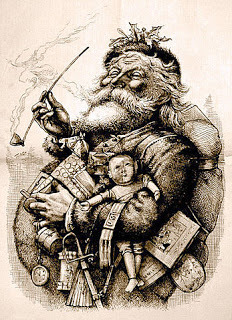 For as long as I can remember, I’ve loved Christmas and the holiday season. Some of my favorite holiday traditions originated during the reign of Queen Victoria, while others had been passed down to the Victorians from generations long past.
For as long as I can remember, I’ve loved Christmas and the holiday season. Some of my favorite holiday traditions originated during the reign of Queen Victoria, while others had been passed down to the Victorians from generations long past.Some of my favorite holiday traditions that were also part of a Victorian Christmas are:
 ~ Reading A Christmas Carol — Charles Dickens’s classic tale was first published in 1843.
~ Reading A Christmas Carol — Charles Dickens’s classic tale was first published in 1843. ~ Waiting for Santa Claus’s arrival — the Dutch legend of Sinter Klass became known to the English as Santa Claus in the 1870s.
~ Christmas Cards — A London merchant first printed cards intended to serve as Christmas greetings in 1843.

 ~ Christmas Trees — The enduring holiday custom became popular in England after Prince Albert and Queen Victoria displayed a decorated tree in Windsor Castle, reflecting the prince’s German heritage.
~ Christmas Trees — The enduring holiday custom became popular in England after Prince Albert and Queen Victoria displayed a decorated tree in Windsor Castle, reflecting the prince’s German heritage.~ Christmas Crackers — Invented by a London candy maker in 1848, crackers consist of a paper container for sweets, notes, and small gifts that snaps when opened.
~ Christmas Toys — Mass production made toys more affordable gifts for middle class children.
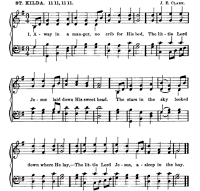 ~ Christmas Carols — A collection of carols was published in 1833. In addition, many classic carols were composed during the Victorian era, including O Little Town of Bethlehem and Away in a Manger.
~ Christmas Carols — A collection of carols was published in 1833. In addition, many classic carols were composed during the Victorian era, including O Little Town of Bethlehem and Away in a Manger. ~ Decorating the Home for the Holidays — Decking the halls became popular during Victorian times. Traditional greenery and elaborate decorations added to the festive atmosphere in a Victorian home.
These are Christmas traditions are among my favorites during the holiday season. What are some of the traditions you enjoy that the Victorians also embraced?
To learn more about a Victorian Christmas, you may enjoy:
www.victoriana.com/Victorian_Christmas/Christmas_in_the_Victorian_Times.html
www.historic-uk.com/HistoryUK/HistoryofEngland/A-Victorian-Christmas/
www.bbc.co.uk/victorianchristmas/history.shtml
Historical Romance - New from Tara Kingston

Here’s a little about my latest release, The Highlander Who Loved Me, a Victorian Scottish romance with an air of mystery:
Johanna Templeton is on a life-and-death quest. Swept into an intrigue that rivals the tales she pens, she joins forces with a Highland rogue to find the treasure that will save her kidnapped niece—a prize the Scot seeks for reasons that have nothing to do with ransom. Engaging the Highlander in a sizzling battle of the sexes, Johanna shields her heart.
Connor MacMasters, spy for Queen Victoria, is a man on a mission—keep a legendary gemstone from an evil man. Trailing an American novelist who holds the key to the treasure should’ve been simple, but Johanna awakens feelings he’d long thought dead. Torn between duty and desire, he wants her in his bed, but loving her would be a fool’s game. Blasted shame his heart doesn’t agree.
To purchase The Highlander Who Loved Me or read an excerpt:
http://entangledpublishing.com/the-highlander-who-loved-me/
Still on sale! When A Lady Deceives - Victorian historical romance, now just 99 cents!
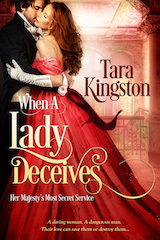
Here's a little about the story:
A woman with a secret and a dangerous man forge an undeniable passion.In Victorian London, reporter Jennie Quinn employs deception as a weapon. Going undercover to seek justice for a murdered informant, she’s drawn into a powerful criminal’s seductive game of cat and mouse. Enigmatic former lawman Matthew Colton is as dangerous as he is clever, but the passion in his kiss is too tempting to resist. She aches to trust him, but she will not abandon her quest for the truth. Colton is a man with secrets of his own. Thirsting for vengeance, the disgraced Scotland Yard detective has infiltrated the criminal world he’s vowed to destroy. Jennie intrigues him, even as she breaks down the barriers around his heart. He yearns to uncover her secrets—in and out of his bed. Driven to shield her, he’ll risk everything to protect the woman whose love heals his soul.
To purchase When A Lady Deceives or read an excerpt:
http://entangledpublishing.com/when-a-lady-deceives/ About The Author:Amazon best-selling and award-winning author Tara Kingston writes historical romance laced with intrigue, danger, and adventures of the heart. A Southern belle-out-of-water in a quaint Pennsylvania town, she lives her own love story with her real-life hero in a cozy Victorian. The mother of two sons, Tara's a former librarian whose love of books is evident in her popping-at-the-seams bookcases. It goes without saying that Tara's husband is thankful for the invention of digital books, thereby eliminating the need for yet another set of shelves. When she's not writing, reading, or burning dinner, Tara enjoys cycling, hiking, and cheering on her favorite football team. Sign up for Tara's Newsletter at www.tarakingston.com/newsletter-signup/Connect with Tara at www.tarakingston.com and on Facebook: https://www.facebook.com/AuthorTaraKingston
Published on December 20, 2016 20:57
December 18, 2016
HOLIDAY AUDIOBOOK PROMOTION
Welcome to the Holiday Audiobook Promotion!!!!

9 Best Selling Authors have come together to celebrate the holidays by giving away audiobooks! Join Eliza Knight, Callie Hutton, Elizabeth Rose, Julie Johnstone, Tanya Anne Crosby, Lauren Smith, Amanda Mariel, Dawn Brower, and Amy Jarecki and participate in this wonderful giveaway!
Giveaway runs December 18-22.
1. The grand prize is a 1 year audible subscription 2. Second Prize: 9 Audiobooks! 1 from each author participating ( The Time Traveler’s Christmas, The Highlander’s Charm, Highland Storm, A Run for Love, Tempted by a Rogue, Onyx, Enchanted by the Earl, Wicked Highland Wishes, and A Wallflower's Christmas Kiss)
How to Enter: Go to the Rafflecopter (http://gvwy.io/ehjb3lx)Listen to each audiobook sampleAnswer the corresponding question in the rafflecopter for each author’s book
Giveaway ends on December 22. Winners will be picked after the giveaway officially ends.
Click here to listen to a sample from The Highlander's Charm -- and then answer the question below!

Published on December 18, 2016 09:56
December 13, 2016
Yuletide with a Dutch Pirate
What do pirates do at Christmastime? Raid, of course.
Pirate Laurens de Graaf had himself a fine Christmas in 1683 when he raided Cartagena.
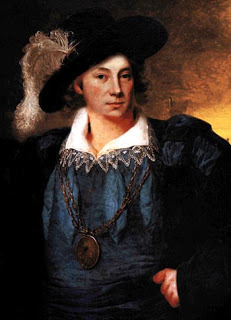 Gesel van de West
Gesel van de West
Dutch for "Scourge of the West"Laurens Cornelis Boudewijn de Graaf (1653-1704) was a successful pirate. Hey, any day you don’t end up hanging from the gallows makes you successful. He was born in the Dutch Republic (Netherlands, today) but was kidnapped as a child by Spanish slavers and sold in the Canary Islands. Fifteen years later, de Graaf emerged a free man and soon found his calling, going on the account as a French privateer. By the 1670s, the tall, blonde, handsome de Graaf had become legendary. Even privateer—though questionable in his exploits—turned Jamaican governor Henry Morgan called him a “great and mischievous pirate”. He captured and looted a great many ships, turning some to piracy thereby growing his fleet. He had no fear in attacking a Spanish armada and was formidable at open sea battles. De Graaf and his fleet were prosperous men.
In November 1683, de Graaf and his fleet arrived off the coast of Cartagena. They dropped anchor taking a month to plan their invasion of the city by water and by land. As you might imagine, this made the people quite uneasy. In an effort to save his town, Governor Juan de Pando Estrada commandeered three well-gunned slave ships and outfitted them with reportedly eight hundred men. On Christmas eve, they sailed out to meet with de Graaf. But alas, they were no match for the pirates. Nearly one hundred Spaniards were killed compared to the twenty pirates and the three ships fell to Dutch buccaneer.
 Hunting pirates with pirates
Hunting pirates with pirates
On Christmas Day, de Graaf released many of the prisoners, sending a thank you to Governor Estrada for the Christmas presents. The port was blockaded and de Graaf ransomed the rest of the hostages.
Come January, the English offered a pardon and commission, which he declined. He had trust issues, not believing the Spanish would uphold a pardon. But he did sail away from Cartagena without further incident.
Laurens de Graaf continued on with his fortuitous and colorful life, earning him respect on both sides of the law.
Since it is the holidays, treat yourself to a free e-book, just by signing up for my newsletter.About the AuthorJennifer is the award-winning author of the Romancing the Pirate series. Visit her at www.jbrayweber.com or join her mailing list for sneak peeks, excerpts, and giveaways.
Pirate Laurens de Graaf had himself a fine Christmas in 1683 when he raided Cartagena.
 Gesel van de West
Gesel van de WestDutch for "Scourge of the West"Laurens Cornelis Boudewijn de Graaf (1653-1704) was a successful pirate. Hey, any day you don’t end up hanging from the gallows makes you successful. He was born in the Dutch Republic (Netherlands, today) but was kidnapped as a child by Spanish slavers and sold in the Canary Islands. Fifteen years later, de Graaf emerged a free man and soon found his calling, going on the account as a French privateer. By the 1670s, the tall, blonde, handsome de Graaf had become legendary. Even privateer—though questionable in his exploits—turned Jamaican governor Henry Morgan called him a “great and mischievous pirate”. He captured and looted a great many ships, turning some to piracy thereby growing his fleet. He had no fear in attacking a Spanish armada and was formidable at open sea battles. De Graaf and his fleet were prosperous men.
In November 1683, de Graaf and his fleet arrived off the coast of Cartagena. They dropped anchor taking a month to plan their invasion of the city by water and by land. As you might imagine, this made the people quite uneasy. In an effort to save his town, Governor Juan de Pando Estrada commandeered three well-gunned slave ships and outfitted them with reportedly eight hundred men. On Christmas eve, they sailed out to meet with de Graaf. But alas, they were no match for the pirates. Nearly one hundred Spaniards were killed compared to the twenty pirates and the three ships fell to Dutch buccaneer.
 Hunting pirates with pirates
Hunting pirates with piratesOn Christmas Day, de Graaf released many of the prisoners, sending a thank you to Governor Estrada for the Christmas presents. The port was blockaded and de Graaf ransomed the rest of the hostages.
Come January, the English offered a pardon and commission, which he declined. He had trust issues, not believing the Spanish would uphold a pardon. But he did sail away from Cartagena without further incident.
Laurens de Graaf continued on with his fortuitous and colorful life, earning him respect on both sides of the law.
Since it is the holidays, treat yourself to a free e-book, just by signing up for my newsletter.About the AuthorJennifer is the award-winning author of the Romancing the Pirate series. Visit her at www.jbrayweber.com or join her mailing list for sneak peeks, excerpts, and giveaways.
Published on December 13, 2016 01:00
December 6, 2016
KILT OR TUXEDO? by Kathleen Bittner Roth
Welcome back to History Undressed, our regular first Tuesday blogger
and author, Kathleen Bittner Roth!
Kathleen Bittner Roth!
KILT OR TUXEDO?by Kathleen Bittner Roth

What is it about men in kilts or tuxedos that women find so sexy? After all, one is dressed in a skirt while the other is neck-to-ankle in a suit that is rather rigid in its style.

The kilt (the word means to tuck up the clothes around the body) dates back to at least the 16th century, and is not unlike those worn by Celtic warriors during Roman times. Also known as a “plaid”, it was originally a long, full-length swath of material that could be used as a hooded cloak when needed. It didn’t reach its modern stage as a “walking kilt” or “short kilt” until the late 17th or early 18thcentury.

Outlawed for thirty-five years after the Scots rebellion against the English in 1745, once the law was repealed, the kilt was mainly worn by the military. However, a passion of sorts began to build around the garment. Men went out of their way to proudly wear the plaid of their clan in public as a show of protest against not only the former ban, but also against English rule.

The tuxedo, on the other hand, originated in the U.S. in the late 1800’s. This sleek garment was named after Tuxedo Park, a socially elite enclave in the Upstate New York countryside populated by the wealthiest of Manhattan’s citizens. Fashioned after the British dinner jacket or smoking jacket with a shawl collar, and at the time, always in black, young dandies began showing up at formal events in their new “uniform of the elite.” Soon, it became de rigueur as a means of showing class and money.

While the kilt represented a show of strength, and the power to rebel if need be, the tuxedo represented power in the form of wealth and élan. James Bond often wears a tuxedo, and some of the most popular romance books feature men in kilts, both branding the men as bold and brave, each in its own way. These two uniforms represent a dichotomy of style, but at the same time, appear to be equally sensual and masculine.

Sexy is the man who shows up at an event meticulously dressed in a tuxedo and bow tie, only to become much sexier as the evening wears on when the tie is undone, or the shirt is unbuttoned in increments—a suggestive promise of good things to come.

How sexy is the man who shows up in a full-dress kilt only to toss off the top half of his clothing in a moment of wild abandon? He stands before us wearing nothing but his kilt—and aren’t we viscerally aware that he wears nothing beneath that kilt!

In my third book in the series Those Magnificent Malverns, His Lordship’s Wild Highland Bride, the heroine is a sassy Scottish lass forced to marry an Englishman. While she does wear a gown fashioned from the MacGregor plaid, it is her handsome, rogue of a brother who shows up in a kilt, causing the inquisitive Malvern females to wonder what might lie beneath all that plaid.
He marries for her dowry. She marries to escape a hanging. HIS LORDSHIP’S WILD HIGHLAND BRIDE.
Kathleen Bittner Roth creates evocative stories featuring characters forced to draw on their strength of spirit to overcome adversity and find unending love. Her own fairy tale wedding in a Scottish castle led her to her current residence in Budapest, Hungary, considered one of Europe’s most romantic cities. A PAN member of Romance Writers of America®, Kathleen was a finalist in the prestigious Golden Heart® contest.
You can find Kathleen at:
Website: www.kathleenbittnerroth.comFacebook: facebook.com/Kathleen.bittnerroth.authorTwitter: @K_BittnerRothBook trailer: https://www.youtube.com/watch?v=GzWQNWFHvhUPinterest https://hu.pinterest.com/bittnerroth/Goodreads https://www.goodreads.com/author/show/7306082.Kathleen_Bittner_Roth
KILT OR TUXEDO?by Kathleen Bittner Roth

What is it about men in kilts or tuxedos that women find so sexy? After all, one is dressed in a skirt while the other is neck-to-ankle in a suit that is rather rigid in its style.

The kilt (the word means to tuck up the clothes around the body) dates back to at least the 16th century, and is not unlike those worn by Celtic warriors during Roman times. Also known as a “plaid”, it was originally a long, full-length swath of material that could be used as a hooded cloak when needed. It didn’t reach its modern stage as a “walking kilt” or “short kilt” until the late 17th or early 18thcentury.

Outlawed for thirty-five years after the Scots rebellion against the English in 1745, once the law was repealed, the kilt was mainly worn by the military. However, a passion of sorts began to build around the garment. Men went out of their way to proudly wear the plaid of their clan in public as a show of protest against not only the former ban, but also against English rule.

The tuxedo, on the other hand, originated in the U.S. in the late 1800’s. This sleek garment was named after Tuxedo Park, a socially elite enclave in the Upstate New York countryside populated by the wealthiest of Manhattan’s citizens. Fashioned after the British dinner jacket or smoking jacket with a shawl collar, and at the time, always in black, young dandies began showing up at formal events in their new “uniform of the elite.” Soon, it became de rigueur as a means of showing class and money.

While the kilt represented a show of strength, and the power to rebel if need be, the tuxedo represented power in the form of wealth and élan. James Bond often wears a tuxedo, and some of the most popular romance books feature men in kilts, both branding the men as bold and brave, each in its own way. These two uniforms represent a dichotomy of style, but at the same time, appear to be equally sensual and masculine.

Sexy is the man who shows up at an event meticulously dressed in a tuxedo and bow tie, only to become much sexier as the evening wears on when the tie is undone, or the shirt is unbuttoned in increments—a suggestive promise of good things to come.

How sexy is the man who shows up in a full-dress kilt only to toss off the top half of his clothing in a moment of wild abandon? He stands before us wearing nothing but his kilt—and aren’t we viscerally aware that he wears nothing beneath that kilt!

In my third book in the series Those Magnificent Malverns, His Lordship’s Wild Highland Bride, the heroine is a sassy Scottish lass forced to marry an Englishman. While she does wear a gown fashioned from the MacGregor plaid, it is her handsome, rogue of a brother who shows up in a kilt, causing the inquisitive Malvern females to wonder what might lie beneath all that plaid.
He marries for her dowry. She marries to escape a hanging. HIS LORDSHIP’S WILD HIGHLAND BRIDE.
Kathleen Bittner Roth creates evocative stories featuring characters forced to draw on their strength of spirit to overcome adversity and find unending love. Her own fairy tale wedding in a Scottish castle led her to her current residence in Budapest, Hungary, considered one of Europe’s most romantic cities. A PAN member of Romance Writers of America®, Kathleen was a finalist in the prestigious Golden Heart® contest.
You can find Kathleen at:
Website: www.kathleenbittnerroth.comFacebook: facebook.com/Kathleen.bittnerroth.authorTwitter: @K_BittnerRothBook trailer: https://www.youtube.com/watch?v=GzWQNWFHvhUPinterest https://hu.pinterest.com/bittnerroth/Goodreads https://www.goodreads.com/author/show/7306082.Kathleen_Bittner_Roth
Published on December 06, 2016 00:00
November 17, 2016
Cover Reveal: The Alice Network by Kate Quinn
I am so thrilled to share with you the cover for Kate Quinn's highly anticipated new book -- THE ALICE NETWORK which releases in June!

In an enthralling new historical novel from national bestselling author Kate Quinn, two women—a female spy recruited to the real-life Alice Network in France during World War I and an unconventional American socialite searching for her cousin in 1947—are brought together in a mesmerizing story of courage and redemption.
1947. In the chaotic aftermath of World War II, American college girl Charlie St. Clair is pregnant, unmarried, and on the verge of being thrown out of her very proper family. She's also nursing a desperate hope that her beloved cousin Rose, who disappeared in Nazi-occupied France during the war, might still be alive. So when Charlie's parents banish her to Europe to have her "little problem" taken care of, Charlie breaks free and heads to London, determined to find out what happened to the cousin she loves like a sister.
1915. A year into the Great War, Eve Gardiner burns to join the fight against the Germans and unexpectedly gets her chance when she's recruited to work as a spy. Sent into enemy-occupied France, she's trained by the mesmerizing Lili, the "Queen of Spies", who manages a vast network of secret agents right under the enemy's nose.
Thirty years later, haunted by the betrayal that ultimately tore apart the Alice Network, Eve spends her days drunk and secluded in her crumbling London house. Until a young American barges in uttering a name Eve hasn't heard in decades, and launches them both on a mission to find the truth...no matter where it leads.
"The Alice Network, which hinges on the unsung valor of female espionage agents in the Great War, perfectly balances a propulsive plot, faultlessly observed period detail, and a cast of characters so vividly drawn that I half expected to blink and see them standing in front of me. This is historical fiction at its best--thrilling, affecting, revelatory." --Jennifer Robson, international bestselling author of Moonlight Over Paris
"Both funny and heartbreaking, this epic journey of two courageous women is an unforgettable tale of little-known wartime glory and sacrifice. Quinn knocks it out of the park with this spectacular book!" -- Stephanie Dray, New York Times bestselling author of America's First Daughter
"A ring of daring female spies known as the Alice Network left a legacy of blood and betrayal. Two women suffering the losses of two different wars must join forces, one to find her voice and her redemption, the other to face her fears and her oldest enemy. Kate Quinn strums the chords of every human emotion with two storylines that race over continents and through decades to converge in one explosive ending." --Marci Jefferson, author of The Girl on the Golden Coin
PRE-ORDER your copy today!
AmazonBarnes and Noble

In an enthralling new historical novel from national bestselling author Kate Quinn, two women—a female spy recruited to the real-life Alice Network in France during World War I and an unconventional American socialite searching for her cousin in 1947—are brought together in a mesmerizing story of courage and redemption.
1947. In the chaotic aftermath of World War II, American college girl Charlie St. Clair is pregnant, unmarried, and on the verge of being thrown out of her very proper family. She's also nursing a desperate hope that her beloved cousin Rose, who disappeared in Nazi-occupied France during the war, might still be alive. So when Charlie's parents banish her to Europe to have her "little problem" taken care of, Charlie breaks free and heads to London, determined to find out what happened to the cousin she loves like a sister.
1915. A year into the Great War, Eve Gardiner burns to join the fight against the Germans and unexpectedly gets her chance when she's recruited to work as a spy. Sent into enemy-occupied France, she's trained by the mesmerizing Lili, the "Queen of Spies", who manages a vast network of secret agents right under the enemy's nose.
Thirty years later, haunted by the betrayal that ultimately tore apart the Alice Network, Eve spends her days drunk and secluded in her crumbling London house. Until a young American barges in uttering a name Eve hasn't heard in decades, and launches them both on a mission to find the truth...no matter where it leads.
"The Alice Network, which hinges on the unsung valor of female espionage agents in the Great War, perfectly balances a propulsive plot, faultlessly observed period detail, and a cast of characters so vividly drawn that I half expected to blink and see them standing in front of me. This is historical fiction at its best--thrilling, affecting, revelatory." --Jennifer Robson, international bestselling author of Moonlight Over Paris
"Both funny and heartbreaking, this epic journey of two courageous women is an unforgettable tale of little-known wartime glory and sacrifice. Quinn knocks it out of the park with this spectacular book!" -- Stephanie Dray, New York Times bestselling author of America's First Daughter
"A ring of daring female spies known as the Alice Network left a legacy of blood and betrayal. Two women suffering the losses of two different wars must join forces, one to find her voice and her redemption, the other to face her fears and her oldest enemy. Kate Quinn strums the chords of every human emotion with two storylines that race over continents and through decades to converge in one explosive ending." --Marci Jefferson, author of The Girl on the Golden Coin
PRE-ORDER your copy today!
AmazonBarnes and Noble
Published on November 17, 2016 06:10
November 10, 2016
Drumroll, Please! Tara Kingston's Gorgeous New Historical Romance Cover...
 Pre-Order Now from Amazon, Barnes & Noble, and other retailers.
Pre-Order Now from Amazon, Barnes & Noble, and other retailers.As a regular contributor to History Undressed and a big fan of this blog, I’m so excited to share the gorgeous cover for my upcoming Scottish Historical romance here today. The Highlander Who Loved Me releases December 12 from Entangled Publishing. Set in late-Victorian Scotland, The Highlander Who Loved Me is the first book in my new Highland Hearts series. The stories are romantic adventures featuring rugged Highland spies working for the Crown to safeguard Scottish treasures.
Here’s a little about The Highlander Who Loved Me:
He may be her fiercest ally...or a scoundrel waiting to betray her.
Johanna Templeton is on a life-and-death quest. Swept into an intrigue that rivals the tales she pens, she joins forces with a Highland rogue to find the treasure that will save her kidnapped niece--a prize the Scot seeks for reasons that have nothing to do with ransom. Engaging the Highlander in a sizzling battle of the sexes, Johanna shields her heart.
Connor MacMasters, spy for Queen Victoria, is a man on a mission--keep a legendary gemstone from an evil man. Trailing an American novelist who holds the key to the treasure should've been simple, but Johanna awakens feelings he'd long thought dead. Torn between duty and desire, he wants her in his bed, but loving her would be a fool's game. Blasted shame his heart doesn't agree.
Published on November 10, 2016 09:30
November 8, 2016
John Gow - The Orkney Pirate
Everything recorded about the infamous Scottish pirate John Gow could be true...or not. It seems that for each report on the Orkney Pirate there was a vastly differing account. Even his youth is questionable.
John Gow was born in 1698, or thereabout, in Wick, Caithness, in the far north of Scotland and raised in Stromness, Orkney Mainland, Scotland. Growing up in a port town, it is not surprising Gow was lured to a seaman’s life. Some local traditional stories claim he ran away to the sea. Others suggest he started his mariner career on trading ships. No one is really sure. There is not much about Gow before he officially became labeled a pirate in 1724.
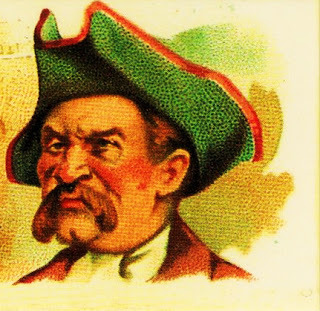 John GowHowever, his piratical ways may have started sooner. It is said that he plotted a mutiny on one of his first voyages, a trip from London to Lisbon, but failed to recruit enough men. His scheme was found out and he fled to Amsterdam. Seems he was a troublemaker from the start.
John GowHowever, his piratical ways may have started sooner. It is said that he plotted a mutiny on one of his first voyages, a trip from London to Lisbon, but failed to recruit enough men. His scheme was found out and he fled to Amsterdam. Seems he was a troublemaker from the start.
In August of 1724, he joined the crew of Captain Freneau’s Caroline bound for Santa Cruz. He must have impressed the captain as Gow was quickly appointed second mate and gunner. By the time they reached the island, there was already growing unrest among the men. The food rations and living conditions were bad and reportedly there was maltreatment by the ship’s officers. After several weeks in Santa Cruz, the Caroline, loaded with beeswax, leather, and woolens, set a course to Genoa, Italy. Captain Freneau was well aware of the crew’s discontent. Despite that the captain had said complaints would be redressed, there were crewmen openly disobeying his orders. Freneau, recognizing the danger, took proactive measures and had small arms placed in the cabin for defense and enforcing discipline. But this was to no avail. Gow and other conspirators caught wind and decided on immediate action. That night after the evening prayer when half of the crew retired, mutineers cut the throats of the surgeon, first mate, and supercargo. The surgeon managed to make it topside where, by some accounts, he was shot. The commotion alerted Freneau on deck. The captain was stabbed in the neck by one of the mutineers, shot in the stomach twice (or more, emptying an entire brace) by Gow, and tossed overboard. The ship was now under the control of the mutineers. Gow, fancying being a pirate, found his opportunity and his co-conspirators agreed to commence in the trade. Gow was elected captain and he renamed the ship Revenge.
 Gow's ExecutionGow preyed on ships off the Iberian Peninsula and in the Bay of Biscayne. While he was successful in his acts of piracy, he did so with a heavy hand in fear yet without unnecessary bloodshed, often releasing prisoners relatively unharmed. But living a pirate’s life meant being short of essential provisions, such as fresh water. Gow lacked necessities, was being hunted, and his ship was in need of repairs. He presented to his crew sailing to Orkney where they could sell their plunder and handle all their urgencies. Oh, and by the way, there are isolated manors and estates of gentry folk that would be easy to pillage. It would be hit and run, and the Revenge would be on its way again.
Gow's ExecutionGow preyed on ships off the Iberian Peninsula and in the Bay of Biscayne. While he was successful in his acts of piracy, he did so with a heavy hand in fear yet without unnecessary bloodshed, often releasing prisoners relatively unharmed. But living a pirate’s life meant being short of essential provisions, such as fresh water. Gow lacked necessities, was being hunted, and his ship was in need of repairs. He presented to his crew sailing to Orkney where they could sell their plunder and handle all their urgencies. Oh, and by the way, there are isolated manors and estates of gentry folk that would be easy to pillage. It would be hit and run, and the Revenge would be on its way again.
The January of 1725, the Revenge, now called George, reached Orkney. Gow passed himself off as a wealthy trader named Mr. Smith. No points for originality. It wasn’t long before Gow and some of his men were recognized by another merchant and everything began to unravel. As word got around of Gow’s true identity and purpose, several of his men deserted him and fled to the Scottish mainland. One bought a horse and fled to Kirkwall, claiming he was forced to be listed in the service of the devil, and warned the authorities of Gow’s plans.
Regardless of being ousted, Gow would not surrender and instead launched his attacks.
Gow stormed the Hall of Clestrain. Depending on which account is read, the raid either was successful in their plunder or the valuables had been hidden and the thieves made off with nothing but a handful of silver spoons. Upon the pirates’ exit, they kidnapped two girls. Stories conflict on the fate of the girls. Some say they were released the next day laden with gifts. Others claim the girls were horrifically abused, one dying from her injuries.
Gow wasn’t done. He set his sights on the Carrick House on Eday. Winds and tide carried the Revenge too close to shore and the ship was grounded. James Fea, the resident of the manor and not-so-coincidentally an old schoolmate of Gow’s, managed to perpetuate any negotiations and, with the aid of only a few men, captured the pirate and his twenty-seven crewmen.
 Never taunt the man with nothing to lose.
Never taunt the man with nothing to lose.
Click HERE for your copy!The pirates were taken to Marshalsea Prison in England to face trial. Gow refused to plea for which he was ordered to be slowly, as in the course of many days, pressed to death. Gow had a change of heart and pleaded not guilty. But alas, the chap was quickly found guilty of murder and piracy. Eight pirates, including Gow, were executed by hanging on June 11, 1725. That was a short piratical career—less than a year.
But the story doesn’t end there. Gow’s rope didn’t break his neck when he fell and he was slow to die, nearly four minutes according to one report. Friends (or the executioner) had pulled upon his legs to speed up his death causing the rope to break. Gow, of his own accord, climbed the gallows again to be hung a second and final time.
The Orkney Pirate and his men were tarred and hung in chains over the bank of the Thames River.
Who really knows the incidental details of John Gow. No matter the tale, whether he was gentlemanly and charitable or not in his dealings, there is no doubt he was a murderer, a thief, a pirate.
About the AuthorJennifer is the award-winning author of the Romancing the Pirate series. Visit her at www.jbrayweber.com or join her mailing list for sneak peeks, excerpts, and giveaways.
John Gow was born in 1698, or thereabout, in Wick, Caithness, in the far north of Scotland and raised in Stromness, Orkney Mainland, Scotland. Growing up in a port town, it is not surprising Gow was lured to a seaman’s life. Some local traditional stories claim he ran away to the sea. Others suggest he started his mariner career on trading ships. No one is really sure. There is not much about Gow before he officially became labeled a pirate in 1724.
 John GowHowever, his piratical ways may have started sooner. It is said that he plotted a mutiny on one of his first voyages, a trip from London to Lisbon, but failed to recruit enough men. His scheme was found out and he fled to Amsterdam. Seems he was a troublemaker from the start.
John GowHowever, his piratical ways may have started sooner. It is said that he plotted a mutiny on one of his first voyages, a trip from London to Lisbon, but failed to recruit enough men. His scheme was found out and he fled to Amsterdam. Seems he was a troublemaker from the start.In August of 1724, he joined the crew of Captain Freneau’s Caroline bound for Santa Cruz. He must have impressed the captain as Gow was quickly appointed second mate and gunner. By the time they reached the island, there was already growing unrest among the men. The food rations and living conditions were bad and reportedly there was maltreatment by the ship’s officers. After several weeks in Santa Cruz, the Caroline, loaded with beeswax, leather, and woolens, set a course to Genoa, Italy. Captain Freneau was well aware of the crew’s discontent. Despite that the captain had said complaints would be redressed, there were crewmen openly disobeying his orders. Freneau, recognizing the danger, took proactive measures and had small arms placed in the cabin for defense and enforcing discipline. But this was to no avail. Gow and other conspirators caught wind and decided on immediate action. That night after the evening prayer when half of the crew retired, mutineers cut the throats of the surgeon, first mate, and supercargo. The surgeon managed to make it topside where, by some accounts, he was shot. The commotion alerted Freneau on deck. The captain was stabbed in the neck by one of the mutineers, shot in the stomach twice (or more, emptying an entire brace) by Gow, and tossed overboard. The ship was now under the control of the mutineers. Gow, fancying being a pirate, found his opportunity and his co-conspirators agreed to commence in the trade. Gow was elected captain and he renamed the ship Revenge.
 Gow's ExecutionGow preyed on ships off the Iberian Peninsula and in the Bay of Biscayne. While he was successful in his acts of piracy, he did so with a heavy hand in fear yet without unnecessary bloodshed, often releasing prisoners relatively unharmed. But living a pirate’s life meant being short of essential provisions, such as fresh water. Gow lacked necessities, was being hunted, and his ship was in need of repairs. He presented to his crew sailing to Orkney where they could sell their plunder and handle all their urgencies. Oh, and by the way, there are isolated manors and estates of gentry folk that would be easy to pillage. It would be hit and run, and the Revenge would be on its way again.
Gow's ExecutionGow preyed on ships off the Iberian Peninsula and in the Bay of Biscayne. While he was successful in his acts of piracy, he did so with a heavy hand in fear yet without unnecessary bloodshed, often releasing prisoners relatively unharmed. But living a pirate’s life meant being short of essential provisions, such as fresh water. Gow lacked necessities, was being hunted, and his ship was in need of repairs. He presented to his crew sailing to Orkney where they could sell their plunder and handle all their urgencies. Oh, and by the way, there are isolated manors and estates of gentry folk that would be easy to pillage. It would be hit and run, and the Revenge would be on its way again.The January of 1725, the Revenge, now called George, reached Orkney. Gow passed himself off as a wealthy trader named Mr. Smith. No points for originality. It wasn’t long before Gow and some of his men were recognized by another merchant and everything began to unravel. As word got around of Gow’s true identity and purpose, several of his men deserted him and fled to the Scottish mainland. One bought a horse and fled to Kirkwall, claiming he was forced to be listed in the service of the devil, and warned the authorities of Gow’s plans.
Regardless of being ousted, Gow would not surrender and instead launched his attacks.
Gow stormed the Hall of Clestrain. Depending on which account is read, the raid either was successful in their plunder or the valuables had been hidden and the thieves made off with nothing but a handful of silver spoons. Upon the pirates’ exit, they kidnapped two girls. Stories conflict on the fate of the girls. Some say they were released the next day laden with gifts. Others claim the girls were horrifically abused, one dying from her injuries.
Gow wasn’t done. He set his sights on the Carrick House on Eday. Winds and tide carried the Revenge too close to shore and the ship was grounded. James Fea, the resident of the manor and not-so-coincidentally an old schoolmate of Gow’s, managed to perpetuate any negotiations and, with the aid of only a few men, captured the pirate and his twenty-seven crewmen.
 Never taunt the man with nothing to lose.
Never taunt the man with nothing to lose.Click HERE for your copy!The pirates were taken to Marshalsea Prison in England to face trial. Gow refused to plea for which he was ordered to be slowly, as in the course of many days, pressed to death. Gow had a change of heart and pleaded not guilty. But alas, the chap was quickly found guilty of murder and piracy. Eight pirates, including Gow, were executed by hanging on June 11, 1725. That was a short piratical career—less than a year.
But the story doesn’t end there. Gow’s rope didn’t break his neck when he fell and he was slow to die, nearly four minutes according to one report. Friends (or the executioner) had pulled upon his legs to speed up his death causing the rope to break. Gow, of his own accord, climbed the gallows again to be hung a second and final time.
The Orkney Pirate and his men were tarred and hung in chains over the bank of the Thames River.
Who really knows the incidental details of John Gow. No matter the tale, whether he was gentlemanly and charitable or not in his dealings, there is no doubt he was a murderer, a thief, a pirate.
About the AuthorJennifer is the award-winning author of the Romancing the Pirate series. Visit her at www.jbrayweber.com or join her mailing list for sneak peeks, excerpts, and giveaways.
Published on November 08, 2016 01:00
November 1, 2016
HALOTTAK NAPJA A Very Different Holiday Atmosphere by Kathleen Bittner Roth
Welcome back to History Undressed, our regular first Tuesday blogger and author, Kathleen Bittner Roth! Kathleen Bittner Roth! HALOTTAK NAPJAA Very Different Holiday Atmosphereby Kathleen Bittner Roth
Tradition and ceremony is the ‘glue’ that binds families and nations together. Ever since I was a child, I have been fascinated with the traditions and ceremonies upheld by various cultures. As an author who is single, and with an adult child married and living a life of his own, my circumstances allow me to live wherever I choose. Even though I am an American through and through, I currently reside in beautiful Budapest, Hungary. As I write this post, I am in the midst of a two-day, national holiday that is part of a tradition that has gone on for centuries, and still impacts the culture to this day.

While children in the U.S. are dressing up in costumes, carving pumpkins, and seeking candy treats, Eastern Europe is embracing a rather somber celebration. As a Catholic nation since the 11th century, Hungary takes the holiday very seriously. Shops, schools and businesses are closed November first for All Saints' Day, and again on November second for All Souls' Day. Families gather together, many of them travelling long distances.

November first, All Saints' Day, means families attend church to remember the saints and their dearly departed. Come evening, people collect in cemeteries to place flowers on the graves of loved ones and burn specially decorated candles to help the departed souls find their way to everlasting light. Years ago, it was traditional for families to have a sumptuous feast at the gravesite and leave food and drink for the departed, so it is not unusual to see the tradition still taking place with some families. We expats, with no descendants amongst the departed, make a pilgrimage to the cemeteries right beside the Hungarians. Especially to the famous Kerepesi Cemetery, coined a ‘decorative’ cemetery because it contains ancient wooden graves known as ‘kopfa’ which date back to the original Magyars, and carved boats symbolizing the journey down the river of death. This cemetery is also the resting place of many influential Hungarian figures.
As dismal as this tradition might seem, it is not. It is, in fact, quietly festive. The cemeteries are strung with lights, while a host of candles, lanterns, and flowers are set in place. The resulting beauty of the grounds is breathtaking. The lights, lanterns and candles are left to burn at least until the next day, which is All Souls' Day, (also known as Day of the Dead in many countries).
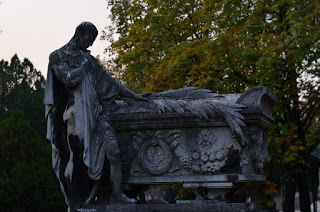
In Hungary, this somber holiday tradition is called Hallottak Napja. In Poland, All Saints Day is known as Dzien Wszystkich Swietych and All Souls Day is known as Zaduszki, when doors and windows are left open to welcome the spirits of the dead. Cemeteries are visited as well, and in Poland a kind of bread called Panska Skorka is sold at the entrance to the cemeteries. Translated the words mean “the Lord’s Crust.”
While the black cat in the U.S. is a symbol of Halloween, and accompanies a witch as her “familiar”, in Russia, the black cat and blue cat (Burmese, Russian Blue and British Blue) are revered because they are thought to bring good luck.

Of the saints remembered in Hungary on All Saints Day, two of the more popular were once members of the Arpad house, the first dynasty of the Hungarian kings which include St. Stephen, the king who brought Christianity to Hungary, and his son, St. Imre, a prince.
Kathleen Bittner Roth thrives on creating passionate stories featuring characters who are forced to draw on their strength of spirit to overcome adversity and find unending love. Her own fairy tale wedding in a Scottish castle led her to her current residence in Budapest, Hungary, considered one of Europe’s most romantic cities. However, she still keeps one boot firmly in Texas and the other in her home state of Minnesota. A member of Romance Writers of America®, she was a finalist in the prestigious Golden Heart® contest. Find Kathleen on Facebook, Goodreads, Twitter, Pinterest and www.kathleenbittnerroth.com.

PORTRAIT OF A FORBIDDEN LADY is book two in Those Magnificent Malverns series: A young widow returns to her childhood home after a forced absence and faces her first and only love, but despite their powerful attraction, danger compels her to remain his forbidden lady. ORDER YOUR COPY!
THE SEDUCTION OF SARAH MARKS is book one in Those Magnificent Malverns series: When a proper Victorian miss awakens next to a handsome stranger, she must rely on the man's benevolence as she struggles to regain her memory and hold onto her heart. ORDER YOUR COPY!
Published on November 01, 2016 00:00



